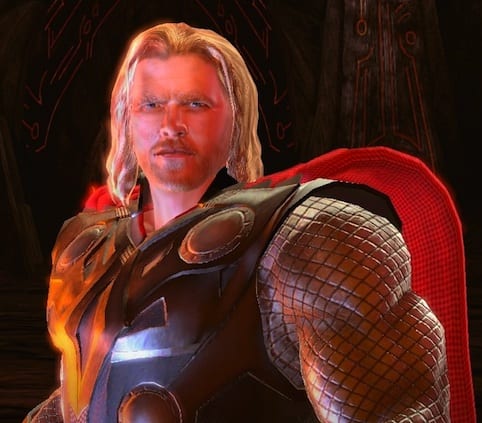In the last few years, comic book fans have been spoiled by games like Batman: Arkham Asylum and Spider-Man: Web of Shadows. So it’s logical to hope that Thor: God Of Thunder, the video game tie in for the Summer movie will follow the trend and not be just another crummy movie tie in. You hoped wrong. Thor: God of Thunder is less Batman: Arkham Asylum and more Iron Man, it’s just what you hoped it wouldn’t be; another subpar movie tie in that doesn’t seem interested in doing enough to stand out. Sure, it does some things great, but even those elements can be found done even better in other games.
logical to hope that Thor: God Of Thunder, the video game tie in for the Summer movie will follow the trend and not be just another crummy movie tie in. You hoped wrong. Thor: God of Thunder is less Batman: Arkham Asylum and more Iron Man, it’s just what you hoped it wouldn’t be; another subpar movie tie in that doesn’t seem interested in doing enough to stand out. Sure, it does some things great, but even those elements can be found done even better in other games.
Much like other movie tie-ins, Thor doesn’t follow the story of its big celluloid brother, rather it features its own unique story written by comics scribe Matt Fraction (who also wrote the Iron Man 2 game). It’s a shame then that the game’s story which finds Loki tricking Thor into causing destruction on other planets, and as a result going back to have to fix things seems so uninspired. You see, rather than really fixing things in Thor, like the game tells you you’ll be doing, you’ll constantly find yourself going through area after area just smashing anyone and anything you can get your hands on. See that crate? Smash it! See that building? Smash it! Yes, you’ve saved this planet!
Most of the game is held down by this repetitiveness as well. Much of the game finds Thor running from one room to another, getting locked in said room and then moving on and repeating. Luckily, the game’s mechanics save it from being a complete bore, at least at first. It’s easiest to compare Thor’s third person action mechanics to that of Sony’s God of War series; mashing on the attack button unleashes a fury of attacks on your opponents, and redirecting the thumbstick in any direction will cause Thor to attack in that direction. It’s a simple and intuitive formula that works well here until you start to realize that it’s the same set of moves repeating again and again.
You do get a break from the monotony of the button mashing though, in the form of the game’s surprisingly well done boss fights. The majority of these bosses are much larger than anything in the game, and as an admitted scale whore, I really enjoyed each of them. While they do of course feature the same basic mechanics, the elements of timing and strategy found in the boss fights makes it feel much different than the other areas of the game.
Playing through Thor, you’ll gain experience points, which in turn will give you tokens. These tokens can be used to upgrade Thor’s abilities, unlock new attacks or health. Exploring in certain areas will result in finding more tokens for these upgrades, but the game is so linear that there’s not really much to explore. In fact, you’ll notice that going pretty much anywhere off the beaten path will result in getting more of these tokens.
Visually, Thor: God of Thunder is a mixed bag, while environments like Asgard and several cityscapes look impressive, the majority of the game looks like it’s straight out of the last console generation. Characters look awkward and move even worse, and some of the environments and objects tend to get pixilated and blocky often. One bright spot in the game is the voiceovers, which are impressive, especially for a licensed game.
Blast Factor: Thor: God of Thunder isn’t a terrible game, it just doesn’t do much to break out of the monotony that hold so many licensed games. It’s a paint by numbers third person action game that if it didn’t have the likeness of Marvel’s Thunder God, wouldn’t even be noticeable. If you’re a huge fan of the character, you may want to check out Thor, otherwise – there’s always Captain America (fingers crossed).



Leave a Reply